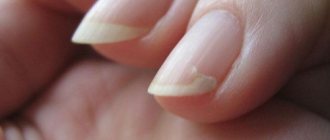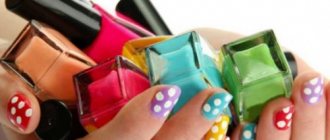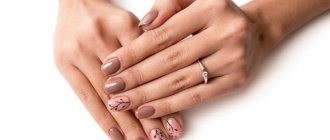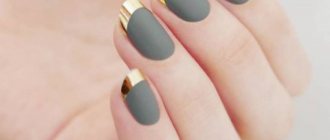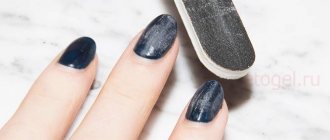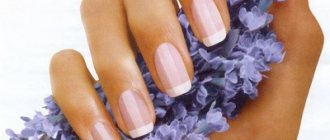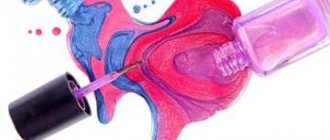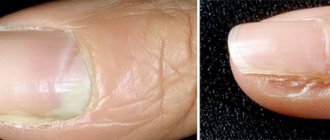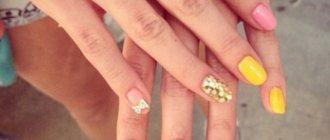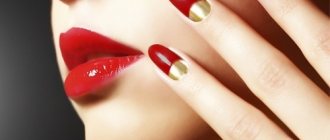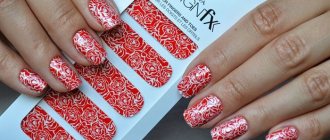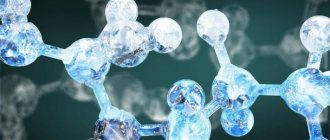For the sake of beauty, women agree to do a lot, sometimes even not at all useful. Expensive services, painful injections, the use of chemicals - this is not the whole list of what the fair sex decides to do in order to be at their best. One of these procedures is coating nails with gel polish. Gel polish is a salvation for modern girls who literally do not have time for a daily manicure. Gel polish lasts at least a week, and sometimes a month, depending on the varnish itself and individual characteristics. However, many people believe that gel polish is harmful to the nail plate. Gel polish contains formaldehyde. If we omit all the features of making nail coatings, we can conclude that formaldehyde is added to cosmetics to increase its shelf life. This substance is an excellent preservative, but that’s where its advantages end. But the range of shortcomings is very extensive.
How harmful is formaldehyde?
- Formaldehyde is used very widely in the chemical industry. It is an important component of foam and plastics. The substance also has antiseptic properties, which allows it to be used for the preservation of body parts in museums. Can such a component be safe for a living organism?
- Formaldehyde is present in many cosmetics. However, it poses the greatest danger when used in nail coatings. The fact is that 80% of all substances that fall on the nails penetrate the blood and, accordingly, the internal organs. Shellac or regular varnish stays on the plates for a long time. Therefore, everything that is placed on them during this period gradually saturates the blood flow.
- The effect of formaldehyde is cumulative. Being a preservative, it gradually affects all organs and tissues. As a result, irreversible changes begin to occur in the body. In particular, the nails themselves deteriorate. They become dry, crack, yellowness appears - and this is just the beginning. Therefore, the harm of nail polish with formaldehyde is obvious.
In Russia there are no laws regulating the level of preservative content in nail coatings. In the West, this is strictly monitored, so in European cosmetics the maximum concentration of formaldehyde does not exceed 0.2%.
What is formaldehyde?
Formaldehyde in nail polish acts as a preservative - it significantly extends its shelf life. On the one hand, there is nothing wrong with this - just think, it’s a preservative. But not everything is so simple!
Preservatives are poisons that, in addition to extending the shelf life of cosmetics, also have a negative impact on our health.
There are different types of preservatives. Some of them are considered very harmful, others are harmful, but to a lesser extent. Therefore, the percentage of danger of a particular cosmetic product will depend on the concentration of the harmful substance. Even a slight excess of the norm can lead to very serious consequences.
Why is this preservative so attractive to manufacturers? Cheap of course! But recently, even those cosmetic companies that prefer the cheapest ingredients are refusing to use formaldehyde.
World practice
The European attitude towards this preservative is very serious. The permissible level of formaldehyde in nail polish should not be higher than 0.2%. But in Russia the attitude towards this dangerous substance still remains indifferent.
Of course, in foreign countries there are cosmetics that contain formaldehyde. It is usually used in shampoos in a concentration of no higher than 0.1%. This is allowed because the shampoo does not come into contact with human skin for long, and formaldehyde itself has little stability in an aqueous solution and gradually reduces its concentration. But even under such conditions, these shampoos are considered unsafe for health.
As already mentioned, in Russia you can most often find formaldehyde in nail polish and other products intended to strengthen and care for them. This means that this poison is in prolonged contact with our nails for a very long time, since varnish, unlike shampoos, is not washed off with water.
Harm of gel polish
Experts do not recommend painting your nails even with simple polish every day: you need to give them regular breaks. It’s easy to understand that constantly wearing gel polish for months will certainly harm the nail plate, because the thick coating limits the access of oxygen. There is one more point - a violation of the natural “immunity” of the nail: under the gel, the plate loses its upper protective layer. What side effects can you notice on your nails after using a low-quality product or applying the coating for too long without resting?
- Yellowing
- Unevenness, lumpiness
- Delamination
- Dullness
- Thinning
- Brittleness, cracking
Using gel polishes with reasonable breaks, combining them with periods of treatment and recovery, and applying only high-quality coatings will not cause any harm! The ideal option is to have gel polish removed from your nails by a manicurist to prevent damage to the nail plate due to improper technology. Do not scrape your nails with sharp objects. After improper removal of gel polish, the nail looks sick, having lost its protective film. But, having carefully studied the procedure for removing the coating, you can perform the procedure at home by carefully dissolving the gel polish and then carefully removing it. It is advisable to select products of the same brand as the gel polish itself.
Myths about the dangers of modern gel polishes
Even advanced scientists find it difficult to assess the supposed harm of gel nail polish or other similar coatings. Therefore, one should not judge that decorative processing of plates is definitely dangerous. For many decades, women have been using decorative cosmetics without compromising their health, and over time, their quality only gets better. Nowadays, lines of products have been developed for use during pregnancy and even during childhood and adolescence. Despite the development of the nail industry and constant improvements in materials and tools, myths about some properties of coatings remain relevant.
If the composition does not contain formaldehyde, the nail polish is considered harmless
In addition to preservatives, unscrupulous manufacturers add other harmful substances to their products: resins, solvents and plasticizers. To protect yourself from exposure to low-quality products, you should purchase only proven, recommended drugs from well-known brands.
Instead of a long-term coating, it is better to use a regular one - it’s safer.
This is a question from the category “is it harmful to paint your nails?” If you look at it, long-term coating turns out to be safer. It is applied for at least 10 days, while the varnish has to be removed every 2-3 days, constantly exposing the plates to a special liquid and applying a new layer. In this regard, gel, shellac and false nails are considered virtually harmless.
UV lamps for nails have been proven to be harmful
What hypochondriacs and women who are looking for an excuse for their unkemptness will not come up with! The UV lamp used in the extension or shellac process is no more harmful than the one that lights up your bedroom. Its only disadvantage is that it is contraindicated for use by cancer patients. If you have serious health problems, it is recommended that you consult with your doctor to see if you can use tools such as an ultraviolet lamp without causing serious harm to your health.
Long-term coating brings only benefits to nails
If you weigh the benefits and harms of gel polish or another type of plate decoration, then the latter will be heavier. Neither extensions nor coloring with shellac bring any advantages, other than aesthetic and economic ones.
False nails are safer than extensions and long-term shellac coating
Many girls ask masters about how harmful false nails are. At first glance, it certainly seems that this type of plate decoration is safer than classic extensions or shellac coating. In fact, there is currently no research to confirm or refute this assumption.
Girls expecting a baby should understand that even in low concentrations, using gel polish during pregnancy will be harmful. It’s better to find a safer, albeit more expensive, alternative.
Can pregnant women use gel polish?
- Pregnant women are very sensitive to any external influences that affect not only them, but also the growing fetus. Pregnant women can use these cosmetics, but with extreme caution and following certain rules.
- Before a manicure, apply a high-quality sunscreen to your hands, which will minimize the harmful effects of the drying lamp.
- The varnishes used must not contain any toxic substances. The bottle should have the inscription 5 free.
- Gel polishes should alternate with regular ones, but it is better if a pregnant woman does not get too carried away with manicure and gives her nails a rest.
- Any varnish can be applied only in a well-ventilated area to avoid vapors entering the body.
- If a manicure is done in a beauty salon, then you need to choose establishments with a proven reputation. In this case, be sure to look at the expiration date of the varnish and the date of the last lamp replacement.
- It is not recommended for a pregnant woman to constantly wear a manicure; her nails already become brittle from hormonal changes in the body.
The effects of nail polish on health
Destruction of the gene pool - global defaults.
Discoveries are constantly being made around the world regarding the negative impact on the gene pool of various goods and products - the fruits of mass technologies of the 20th century and threatening multi-billion-dollar losses for manufacturing corporations.
Corporations, of course, do not need publicity, so scandals with this or that product do not occur immediately, although they inevitably happen anyway. Sometimes a scandal can be postponed for decades, as was the case, for example, with “soft oils” (“spreads”). And sometimes it develops with explosive speed; This is what happens today with chips and hamburgers in Europe. It may gain global proportions - for example, about the worldwide boycott of Nestlé baby food. Or it can quietly confine itself to the confines of one state, which, having protected its population, does not make a fuss and does not meddle unnecessarily in world trade wars and any global processes (this is how, for example, Sweden, the country of victorious socialism, behaves). Russia in this sense is a real Klondike for corporations, which in the rest of the world are being torn apart by national medical departments and various “evil” public organizations. All recent governments (starting with the allied ones and including the current one) did not care at all about this obvious aggression against the gene pool; they had not yet begun to formulate such phrases. And that’s why in Russia the so-called public, not to mention consumers, doesn’t know anything about this.
When, in a few years, the most famous, leading world-famous companies producing cosmetics, perfumes, chewing gum, etc. etc., will begin to receive astronomical claims from consumers, then they will address curses and other wishes to two organizations. The American government Center for Disease Control and Prevention (like our sanitary and epidemiological surveillance) and the influential public organization “Environmental Working Group” (one of those that high business and political circles en masse call “anti-globalists” and other abusive words).
At the end of 2000, the American sanitary department published shocking information about the results of a survey of a group of people for the presence of interesting phthalates in their bodies. It is known about these substances that they can accumulate in the body and over time block the production of male hormones - androgens. Accumulating in a woman’s body, phthalates are transmitted to the fetus, causing defects of the reproductive system in boys. They are also transmitted to the baby through breast milk, years later leading to the development of impotence and infertility.
American orderlies found phthalates in absolutely all subjects, but most of them, 20 times more than the average, were found in young women, as they say, of childbearing age. The source of hazardous substances was absolutely identified - nail polishes.
According to the results of a study conducted by the Department of Toxic Substances Control of the California Environmental Protection Agency.
Checks in beauty salons in the United States have revealed the presence of harmful substances in professional nail polishes.
Samples of 25 nail polishes were taken from Bay Area salons. In varnishes that were considered non-toxic, researchers found samples of a dangerous trio - toluene, dibutyl phthalate and formaldehyde.
Toluene causes headaches, nausea and dizziness, dibutyl phthalate leads to infertility, and formaldehyde is a known carcinogen, which, by the way, is often added to shampoos and shower gels as a bactericidal ingredient. Formaldehyde is most often used in hair straightening products, since products without this component are not as effective. Cancer is too much of a price to pay for straightened hair and well-groomed nails.
Information was picked up from the “environment” and a wide examination of varnishes was carried out. Of those varnishes on which the composition was indicated (and this is a minority of the assortment, even in America), dangerous chemicals were found in every third. It was found in the products of the world's most famous “brands”: Chanel, Christian Dior, Cover Girl, Max Factor, Maybelline, Oil of Olay, Bon Bonz and others.
Almost the entire set of products advertised on Russian television, the most popular among the fair half of the population, is presented.
Subsequently, Russian researchers (of course, from a public, not a government structure) continued the list with cheap brands available on our market (Kiki, Lori, Anne Zala, Collection 2000 and others) and concluded that phthalates are present in at least 80 percent of imported nail polishes. And there are virtually no others on the Russian market. Once upon a time they were produced, and they even tried to create formulations without phthalates, but then production was stopped. But let's return to the Americans. Faced with the fact that so many manufacturers do not indicate the composition of their products, environmental activists conducted research in patent databases. It turned out that phthalates are included, without mentioning it on the label, in a huge number of lotions and shampoos, conditioners and antiperspirants, hair growth products and sunscreen cosmetics, creams and lipsticks, chewing gum and candies...
Among the products of Procter & Gamble alone, there were 37 patents using phthalates. Among other famous corporations, the list included L'Oreal and the already mentioned Maybelline, Colgate Palmoliv and Unilever, Henkel, Revlon, Shiseido, Akzo Nobel, Elizabeth Arden, and others, which were repeatedly mentioned in our column.
Thus, even if you really want to eliminate these dangerous substances from everyday life, if you are planning, for example, to have a child, it will be extremely difficult to do so. The advice that the media often gives in consumer columns - to look at the composition of a product or product - is ineffective, since most manufacturers do not indicate phthalates.
Look for the word “phthalates” itself, or the more precise names “dibutyl phthalate” (DBF), “diethyl phthalate”, “dimethyl phthalate”. But another piece of advice seems more effective. Pregnant, nursing mothers, and women in general planning to have children, it is better to simply give up cosmetics, especially varnishes. If, of course, you want to see your grandchildren someday, and not just any grandchildren, but healthy ones. Of course, you will still get a dose of phthalates; in addition to cosmetics, they are found in many other places. But at least you—there’s a fashionable word among current parliamentarians—minimize it.
Source: alex-jason.livejournal.com
Nail care
If you do carry out such a procedure for your nails, then do not forget to take care of them, because the skin around the nail plate needs care and nourishment with useful substances.
- Hygiene and cleanliness . It is an indisputable fact that you need to keep your hands clean. No matter how banal it may sound, they need to be washed with soap and a hygienic manicure, cutting off hangnails. Due to constant contact with unclean surfaces, pathogenic microorganisms can enter microcracks in the skin, which can cause the development of an inflammatory process. If pain and twitching occur, it is better to immediately consult a doctor rather than treat your finger with warming procedures and ointments.
- Length of nails. You should not grow long nails, since during any manual work the arm muscles will always be in a tense state. An uncomfortable position can lead to neurological diseases accompanied by pain and numbness.
- Care. Depending on the type of skin on your hands and the time of year, you need to select the appropriate cream and use it regularly, applying it to the surface of your hands at least once a day at night. You can also make various baths to strengthen the nail plate after removing the gel polish coating. Grape seed and almond oils, which can be used as a base, have a beneficial effect on the skin and nails.
Expert opinion: what ingredients should you be wary of in nail polishes?
Finding natural nail polish is not an easy task.
When you choose the shade of your dreams at the salon, you probably don’t think about the composition of the product, which includes harsh chemicals. Natural alternatives do exist. “Safe” varnishes are divided into categories depending on the amount of harmful substances that they do not contain. Together with experts, we’ll figure out why it’s so important to carefully study the ingredients on the label and what’s hidden behind the scary words “formaldehyde,” “carcinogens,” and “toluene.” In 2014, all-natural nail polishes from Logona with a patented formula were invented. These are the only varnishes in the world with eco-certificates (six shades in total). However, this is rather an exception to the rule, because in general the composition of varnishes is far from healthy.
When choosing a varnish, you should always remember the three most toxic components:
• toluene; • formaldehyde; • dibutyl phthalates (DBP).
These substances are quite common in nail polishes.
Dibutyl phthalate is believed to promote the growth of cancer cells. This chemical prevents nail polish from breaking, but has been shown to interfere with normal baby development and in some cases cause early menopause. Toluene negatively affects the central nervous system (long-term exposure to this chemical can lead to headaches, dizziness and sometimes serious reproductive problems). Formaldehyde is a known poison that changes protein structure and is used in embalming. It can also cause skin irritation and negatively affect the nervous and immune systems. But the studies were not conducted on humans, so the risk is only potential,
— explained OPI expert Olga Generalova.
She added that for a visible negative effect, a significant dose of these substances is needed, but it is better to try to avoid them in your varnishes, since individual intolerance to these components and a negative reaction to even a small amount of the component cannot be ruled out.
Despite the fact that the Cosmetic Ingredient Review (an organization engaged in research with the support of the American Food and Drug Administration) recognized these ingredients as safe at certain concentrations, none of the existing eco-standards considers them environmentally friendly.
Varnishes marked 5 Free are made without formaldehyde, toluene, dibutyl phthalate, as well as camphor or formaldehyde resin.
Camphor preserves color and prolongs the life of varnish. Not as harmful as previous examples, but it has recently been shown to cause serious skin reactions and, if inhaled, nausea, dizziness and headaches. Formaldehyde resin is not directly linked to the development of cancer like formaldehyde, but it has been noted to cause dermatitis in some patients.
- notes an expert from the Moskvichka Brow & Beauty Bar salon, which uses organic cosmetics with a minimum content of harmful impurities.
In varnishes marked 7 Free you will not find the chemicals described above, as well as xylene and triphenyl phosphate. The former can cause dizziness, nausea and vomiting, while the latter is potentially toxic to liver cells.
The formula of 8 Free varnishes also does not contain ethyl tosylamide and triphenyl phosphate, and 9 Free is produced without parabens and acetone.
Parabens mimic the hormone estrogen and have been linked to breast tumors, while acetone is a chemical that is mostly considered safe, but can cause a sore throat if inhaled.
10 Free polishes do not contain any harmful additives or animal products, so these products can be called vegan.
We've put together a selection of nail polish brands that offer a natural alternative to the harsh chemicals listed above. For example, the Jin Soon brand, created by two manicurists in 2012, is one of the few that produces 10 Free polishes. The composition of the varnishes is supplemented with a sun filter. The color is very dense and rich, so it can be safely applied in one layer.
The first varnish without toxic substances was created and named after our compatriot Zoya Reizis, she founded the Zoya brand. The formulas are also 10 Free, the range includes a palette of all colors of the rainbow. Plus, the polishes have over a thousand positive reviews on Amazon. The British brand London Town went even further. In addition to being free of nine harmful ingredients, this product also contains vitamins and oils to nourish your nails.
Piggy Paint was created by a concerned mother who was concerned about the chemicals in her children's nail polish. The brand's varnishes are natural and odorless. By the way, there are also water-based varnishes (Acquarella, Suncoat Girl, Honeybee Gardens). It contains only a few products: water itself, dyes (often mineral pigments) and polymers. However, the durability of such products cannot be envied - a day at most.
Fedua and Smith & Cult varnishes, which we can find in the same Moskvichka Brow & Beauty Bar, are also not harmful to health. And to strengthen nails, salon experts recommend IBX coating to their clients. It strengthens and smoothes the nail plate, and serves as a protective base for gel manicure.
